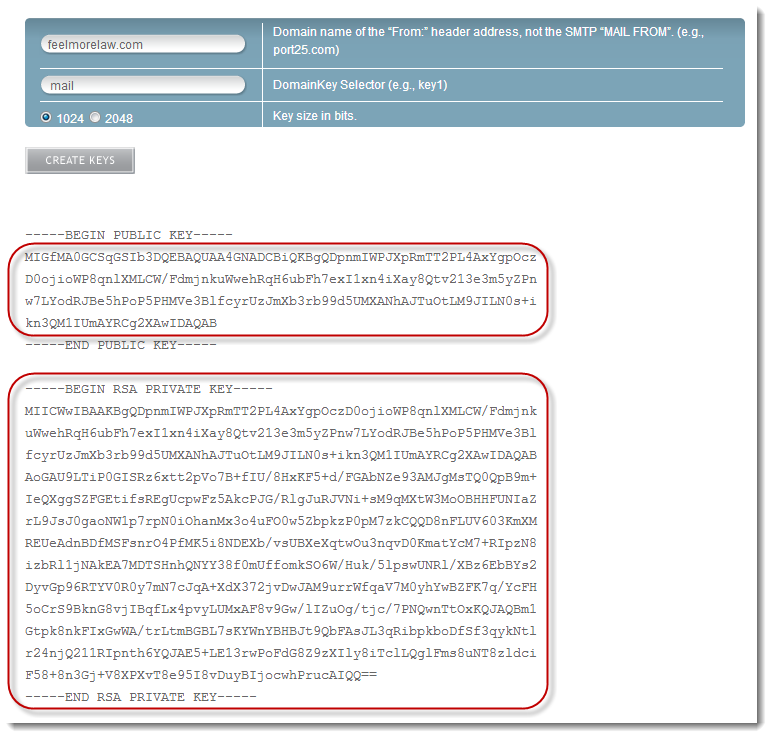DomainKeys Identified Mail (DKIM) is a method for email authentication that allows an organization to take responsibility for a message it has sent in a way that can be validated by a recipient. The technique is based on public-key cryptography: Responsibility is claimed by the signer by adding a digital signature to a message’s header, the DKIM-Signature header field. The verifier recovers the signer’s public key using the DNS, and then verifies that the signed parts have not been altered.
Click the Options tab and select the Enable DKIM Signing checkbox for DKIM or Enable Domain Key check box. Click the Certificate tab. In the Selector field, enter a unique name. Click Generate Key in the content pane toolbar. NAME Get-DkimDomainObject SYNOPSIS Outputs one or more domain's objects in Dkim Manager. SYNTAX Get-DkimDomainObject -DomainName DESCRIPTION The Get-DkimDomainObject cmdlet queries domain(s) from Dkim Manager based on the domain name, wildcard is supported in DomainName.
1. Install DKIM filter
apt-get install dkim-filter
2. Create a key for each domain verified
mkdir -p /etc/dkim/keys/domain1.com
cd /etc/dkim/keys/domain1.com
dkim-genkey -r -d domain1.com
Replace domain1.com with the domain that this mail server should authenticate using DKIM
3. Add a line for each domain to dkim-keys.conf file (pico /etc/dkim-keys.conf)
*@domain1.com:domain1.com:/etc/dkim/keys/domain1.com/default.private
Replace domain1.com with the domain that this mail server should authenticate using DKIM
4. Add a TXT record to the DNS for the domain being authenticated using DKIM. The record is automatically created and stored in /etc/dkim/keys/domain1.com/default.txt. You just need to add it to the DNS server. (cat /etc/dkim/keys/domain1.com/default.txt)
Here’s a sample output:
default._domainkey IN TXT 'v=DKIM1; g=*; k=rsa; p=MIGfMA0GCSqGSIb3DQEBAQUAA4GNADCBiQKBgQC8IQNYlS+8jyrbAxNsghsPrWYgOQQWI0Ab4e9MToZYLTBGI41V3Zet5Awrt19nMIUlTpuE+/YVnjP/pu3fgeYkoe6NUzp+oEcWAioQXBmx0njigac7iJ/I0naTP1xTrDacnwsTp/F+lMwGgjiHpaJA7iBmL0AfYMXlTBo5pFog2QIDAQAB' ; ----- DKIM default for domain1.com

Repeat steps 2, 3 and 4 for every domain that this server should authenticate using DKIM.
5. Uncomment line 37 to make DKIM filter use the dkim-keys.conf file to look up domains available (pico /etc/dkim-filter.conf)
KeyList /etc/dkim-keys.conf
6. Add a inet socket that Postfix can communicate with (pico /etc/default/dkim-filter)
SOCKET='inet:[email protected]'
7. Restart DKIM filter
/etc/init.d/dkim-filter restart
8. Configure Postfix to query DKIM filter using the socket created earlier. Add these lines to main.cf (pico /etc/postfix/main.cf)
milter_default_action = accept
milter_protocol = 2
smtpd_milters = inet:localhost:8891
non_smtpd_milters = inet:localhost:8891
9. Reload Postfix config
postfix reload
How to create a DKIM for your Godaddy domains?
The emails that you send to your prospects might have via freshsales.io appear in the from address when they receive it. If you’d like to hide this in your emails, it is highly recommended that you add DKIM records to your domain.
If the DNS Manager for your domain is hosted with GoDaddy, follow the steps below to add a CNAME and verify the domain.
Login to your GoDaddy DNS Manager. Go to the My Account menu and click Domains.
Under Domains, click the Manage DNS button for the domain you want to verify.
The DNS Manager page will open with information about existing DNS records.
Go down to the Records section and click the Add button to add a DNS record.
Choose CNAME from the drop-down menu, Type.
In the Host field, enter the following four host names: fsemail
In the Points to field, enter fsemail.freshsales.io
Finally click Save.
Repeat step-4 to step-8 to add all other records mentioned as below.
Record Type
Host Name
Value
CNAME
fsemail
fsemail.freshsales.io
CNAME
m1._domainkey
m1._domainkey.freshsales.io
CNAME
fslink
fslink.freshsales.io
CNAME
2022619
fslink.freshsales.io
Go down to the Records section and click the Add button to add a TXT record.
Choose TXT from the drop-down menu, Type.
In the Host field, enter ‘@’ to denote the default domain for email delivery.
In the TXT value, enter v=spf1 include:_spf.freshsales.io ~all
Generate Dkim Key For Domain Godaddy


Click Save
Generate Dkim Key For Domain Hosting
How to verify your domain in Freshales?
After you’ve published the records in your Domain Name System, login into your Freshsales account as Administrator
Navigate to Admin Settings > Email Settings > Outgoing email settings.
Enter your domain name and Verify
Verified domains are listed below the Outgoing email settings.
Did you find it helpful? Yes No
